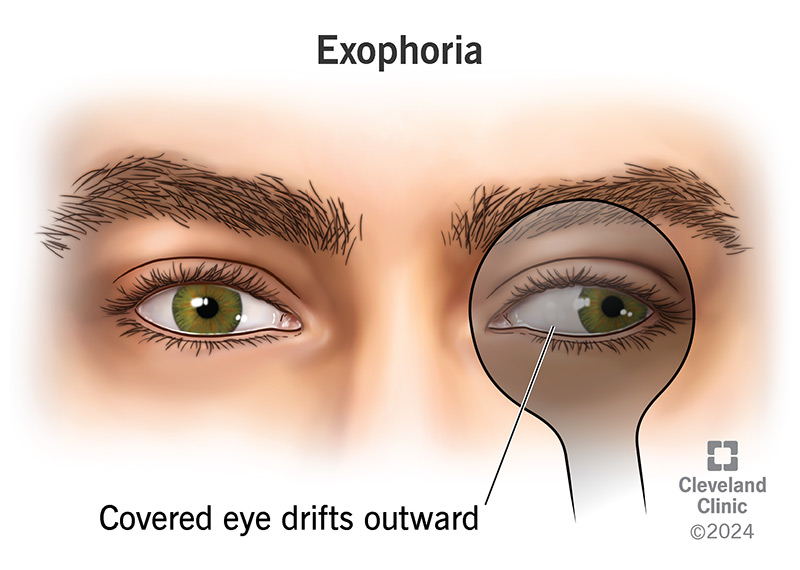Exophoria is when covering one of your eyes makes it drift out of alignment and point outward and away from your nose. This symptom falls under strabismus. Smaller misalignments are normal, and most people don’t notice them. Larger misalignments can cause symptoms or worsen and cause more frequent and more severe alignment issues.
Advertisement
Cleveland Clinic is a non-profit academic medical center. Advertising on our site helps support our mission. We do not endorse non-Cleveland Clinic products or services. Policy

Exophoria is when covering one of your eyes makes it drift outward (away from your nose) and out of alignment. For context, phoria is when covering an eye makes it drift out of alignment.
Advertisement
Cleveland Clinic is a non-profit academic medical center. Advertising on our site helps support our mission. We do not endorse non-Cleveland Clinic products or services. Policy
Smaller misalignments from phoria are normal, and almost everyone has this. But exophoria becomes an issue when the misalignment is big enough. That’s because your eyes and brain have trouble compensating, which disrupts your vision and can lead to constant eye misalignment (strabismus).
Your vision depends on proper eye alignment. When your eyes align properly, your brain can “fuse” the input from both eyes into the single big-picture 3D view that you see. That’s called binocular vision (stereopsis).
When you have significant exophoria, your brain may struggle to fuse the two pictures. That can cause other, more disruptive symptoms like:
When you’re using both eyes, your brain uses what each eye sees to make subtle adjustments to align and focus them. When you cover one eye, that eye can’t use the same reference points as the uncovered eye, so it has trouble staying aligned. That’s why a small amount of phoria is normal.
A few other contributing factors can make exophoria more likely to develop, including:
Advertisement
Exophoria often doesn’t need treatment unless it becomes severe enough to cause other symptoms. It can also worsen and cause tropias, which are misalignments that happen without covering an eye.
The most common treatment options include:
Exophoria isn’t a condition you can self-diagnose, so you need to see an eye specialist to get this diagnosis. You shouldn’t try to self-treat it. If you think you have it, an eye care specialist can guide you on how to manage it.
Exophoria is usually not a major issue. But when it’s more severe, it can get worse over time. That’s known as “decompensated exotropia.” If it decompensates enough, the misalignment can start happening without covering an eye. That’s known as exotropia, and it can be much more disruptive and unpleasant because it can happen without covering an eye.
Even if that doesn’t happen, exophoria can still be unpleasant. Every time your eyes have to realign, your brain and eye muscles have to work a little harder than usual to readjust. That can cause brief moments of double vision, which can cause headaches and eye strain.
One way to think about it is like the wheels on a shopping cart. If the wheels don’t line up right, the cart becomes much harder to control. That means you have to work harder to keep it moving straight, which tires out the muscles in your arms and legs faster. Likewise, misalignment from exophoria can tire out your eye muscles, especially with larger misalignments.
Advertisement
Most people with exophoria don’t know they have it, and it’s rare to notice it on your own. Instead, other symptoms that happen because of exophoria are why people see a healthcare provider or eye care specialist, which leads to the diagnosis. It’s also something an eye specialist or other provider might notice during a routine eye exam (or during routine pediatrician visits for children).
If you have frequent headaches, eye strain or fatigue, or notice vision changes, it’s a good idea to see an eye care specialist. They can check your eye alignment and offer treatment recommendations if necessary.
Exophoria and esophoria are both horizontal (side-to-side) misalignments that happen to an eye when you cover it. Exophoria is when the covered eye turns away from your nose. Esophoria is when the covered eye turns toward your nose.
Exophoria is an outward-pointing eye misalignment that only happens to a covered eye. Exotropia is when an eye misaligns away from your nose without covering it. While they’re very different, exophoria can become exotropia. That’s because your eye tries to compensate for the misalignment and ends up causing a more severe and more frequent misalignment.
Life is easier when things seem to line up right, and that’s especially true for your vision. If your eyes don’t align as they should, it can cause symptoms that are unpleasant or interfere with your activities and routine. You shouldn’t feel silly for asking an eye care specialist if you have these symptoms. Even a misalignment of a few millimeters can cause issues for you. An eye care specialist can find and diagnose the issue and offer you ways to treat it.
Advertisement
Getting an annual eye exam at Cleveland Clinic can help you catch vision problems early and keep your eyes healthy for years to come.

Last reviewed on 02/18/2024.
Learn more about the Health Library and our editorial process.